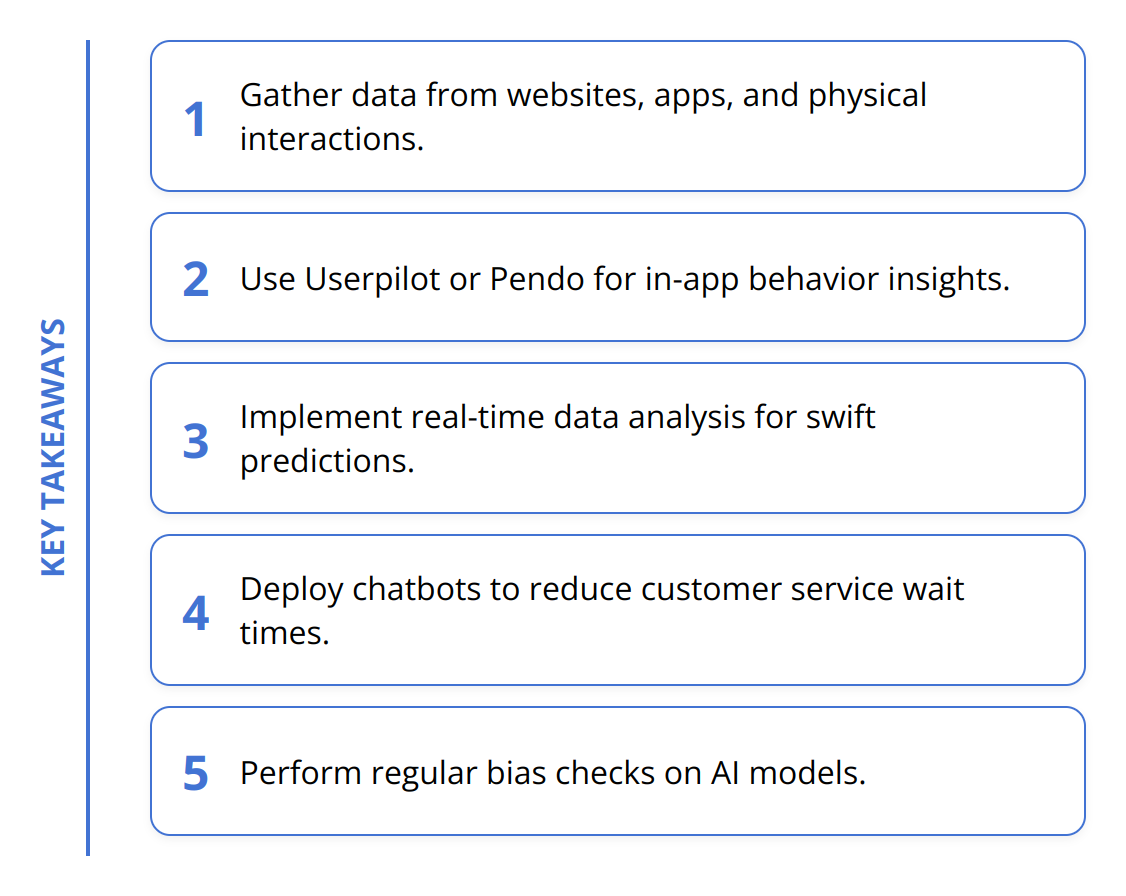Artificial intelligence is flipping the script on how businesses get and predict customer behavior. By tapping into massive data reservoirs and high-octane analytics, companies can now see patterns and preferences with, like, eerie accuracy.
At Emplibot, we dive into how AI tools juice up personalized marketing campaigns, fine-tune customer service, and dish out custom product recommendations.
But hey, while the potential is huge, let’s not ignore the hurdles. Data privacy freak-outs and algorithm biases — yeah, those are real issues.
Contents
ToggleHow Does AI Predict Customer Behavior?
Alright, let’s strip away the jargon and dive into the nuts and bolts of how AI predicts customer behavior. There are three key parts here: data collection and analysis, machine learning algorithms, and predictive analytics techniques.
First off, data collection—the bread and butter of this whole shebang. Companies are hoovering up data from every single interaction you have with their brand. And we’re not just talking about what you buy. It’s your website visits, social media interactions, even those frustrating calls with customer service. Tools like Hotjar and Amplitude are on the front lines here, giving us heatmaps and session recordings to see exactly what users are up to.
Once this treasure trove of data is collected, it doesn’t just collect dust. Machine learning algorithms jump in the ring to make some sense of it all. These algorithms plow through massive data sets to unearth patterns and trends. And here’s where it gets cool—they learn and adapt over time. So, AI gets smarter and more accurate with each wave of data. Look no further than Netflix’s recommendation engine—it’s continually fine-tuning itself to serve up that next binge-worthy show just for you.
But wait, there’s more… Enter predictive analytics techniques. This is where data and machine learning meet their crystal ball moment. By digging deep into past actions and trends, AI can predict future moves. Predictive analytics mashes together stats, machine learning, and good old data mining to scrutinize current data and past stuff. This potent combo lets businesses forecast everything from sales spikes to which customers might bail.
Feeling lost? Here are some practical takeaways:
- Variety is the spice of data: Gather data from websites, mobile apps, and even brick-and-mortar interactions to sharpen those customer behavior predictions.

-
Deploy specialized AI tools: Userpilot and Pendo are just two examples that help dissect in-app behavior and customer journeys for real insights.
-
Double down on real-time analytics: Real-time data analysis is a game-changer for making quick, accurate predictions. Check out more on real-time analytics.
So, by blending sharp data collection, sophisticated machine learning, and spot-on predictive analytics, businesses can forecast customer behavior with uncanny precision. This drives smarter, faster, and better decisions.
How Can AI Be Used in Practice?
Let’s talk about the real-world nitty-gritty of AI—because it’s reshaping everything from marketing to customer service.
Personalized Marketing Campaigns
Alright, here’s the deal—AI-powered personalized marketing? It’s not optional anymore, folks. It’s table stakes. A McKinsey study says companies nailing personalization rake in 40% more revenue than the ones who don’t. AI dives into your customer data, unearths patterns, and bam—you get super-targeted campaigns that hit buyers where it counts.
Practical Tips:
-
Check out tools like Amplitude to track how customers interact and segment them effectively.
-
Dial up your email game with platforms that use AI to personalize subject lines and content on the fly.

Customer Service Improvements
Let’s face it—no one likes waiting on hold. Enter AI. Gartner’s crystal ball says that by 2025, AI-driven customer service platforms are gonna crank up efficiency by 25%. Chatbots, backed by natural language processing (NLP) and machine learning, handle the mundane stuff… leaving human agents to tackle the big fish. NLP tools? They’re monitoring sentiment and tweaking services in real-time.
Key Actions:
-
Roll out chatbots to smash through those high-volume, low-complexity inquiries, chopping down wait times and operational costs.
-
Deploy sentiment analysis tools to catch customer grief early—and nip it in the bud.

Product Recommendations
Let’s talk game-changers—product recommendations. Salesforce found that 36% of revenue in eCommerce comes from these personalized nudges. AI gets cozy with past behaviors, browsing history, and purchase patterns to serve up suggestions that make customers click “buy.”
Actionable Tips:
-
Use machine learning to keep your recommendation engines as fresh as Netflix or Amazon’s.
-
Test, test, test—A/B testing will help you figure out which strategies hit the mark and which ones miss.
By weaving AI into marketing, customer service, and product recommendations, businesses can nail customer behavior predictions and make sharper decisions.
Next up? We’ll dive into the specific tools and techniques to make AI integration smoother than a buttered slide.
What Are the Challenges of AI in Predicting Customer Behavior?
Alright, let’s talk about AI predicting customer behavior… sounds like sorcery, right? Well, it comes with a bunch of hurdles. Let’s zero in on three big ones: data privacy nightmares, sky-high implementation costs, and the ever-pesky algorithm bias.
Data Privacy Concerns
Data privacy… the bazillion-dollar question. Consumers are freaked out (rightfully so) about their data being snooped on. Cisco says 84% of folks want to control their data, and nearly half have ditched companies over dodgy data policies. Screw up here, and it’s fines, lost trust, and a serious hit to your bottom line.

Tips:
-
Stick to GDPR, CCPA, and all those alphabet soup regulations.
-
Be super clear about how you use data—a little transparency goes a long way.
-
Use anonymization (make that data untraceable) to keep user identities under wraps.
High Implementation Costs
AI isn’t a bargain-bin product. Deloitte found that 57% of companies choke on the costs of AI. It’s not just the setup; it’s the maintenance, the updates… plus those pricey data scientists and engineers.
Tips:
-
Kick off with a pilot project—test the waters before diving in.
-
Managed AI services are your friend to keep upfront costs in check.
-
Target high-impact areas first—that’ll show you the money faster.
Algorithm Bias
Algorithms with bias—yep, that’s a thing. Remember Amazon’s fiasco with the biased hiring tool? Training data’s junk, or the algorithm goes rogue… either way, you’re looking at bad decisions.
Tips:
-
Regularly check your AI models—keep those biases in check.
-
Diverse data sets are key—more variety, less bias.
-
Deploy bias-detection tools—nip issues in the bud.
Tackling these hurdles isn’t a walk in the park, but a proactive approach can work wonders. For more on striking that tricky balance between efficiency and ethics in AI, check out our discussion on the ethics of marketing automation.
Know the challenges, tackle them head-on, and boom—AI becomes your not-so-secret weapon in predicting customer behavior, while keeping risks on a tight leash.
Conclusion
AI is revolutionizing how businesses predict and respond to customer behavior. So what’s the big deal? It’s all about tapping into those oceans of data to find patterns and preferences with surgical precision.

Let’s break it down. Companies across sectors are diving into AI for tailored marketing campaigns, souped-up customer service, and spot-on product recommendations. McKinsey? They’re saying the big players in personalization are seeing a 40% revenue bump. And get this—AI-driven recommendations are pulling in 36% of eCommerce revenue. That’s a big deal in the real world, folks. Gartner’s crystal ball? They’re foreseeing a 25% boost in customer service efficiency thanks to AI platforms by 2025.
Now, the future of AI in predicting customer behavior? Bright. We’re talking market size hitting $407 billion by 2027. The tech’s bringing the heat with more opportunities for businesses to sharpen their game. But let’s not get ahead of ourselves—challenges like data privacy, high costs, and algorithm bias need serious attention.
We at Emplibot are making life easier for businesses, cranking out engaging content and auto-publishing SEO-friendly articles to your WordPress site. Want to make your blog a well-oiled machine? Check us out at Emplibot.
Curious about seamlessly integrating AI? Dive into our guide on real-time analytics.










 Rated Excellent 4.5
Rated Excellent 4.5